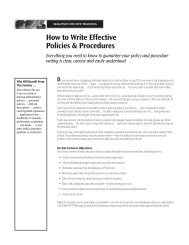Precision Thinking and Problem-solving Skills - SkillPath | Seminars
Precision Thinking and Problem-solving Skills - SkillPath | Seminars
Precision Thinking and Problem-solving Skills - SkillPath | Seminars
- No tags were found...
Create successful ePaper yourself
Turn your PDF publications into a flip-book with our unique Google optimized e-Paper software.
SKILLPATH ON•SITE TRAINING<br />
<strong>Precision</strong> <strong>Thinking</strong> <strong>and</strong><br />
<strong>Problem</strong>-<strong>solving</strong> <strong>Skills</strong><br />
Learn how to be more creative, more innovative—<br />
<strong>and</strong> more effective!<br />
Who Will Benefit<br />
From This Seminar …<br />
Anyone who wants<br />
to learn the creative<br />
problem-<strong>solving</strong><br />
techniques that can<br />
move a company—<br />
<strong>and</strong> a career—ahead<br />
of the rest<br />
Are you facing too many problems at work <strong>and</strong> finding it difficult to develop adequate solutions It’s a common<br />
dilemma, but <strong>SkillPath</strong> can help you solve it! Let us teach you the critical thinking processes you need for<br />
problem <strong>solving</strong>.<br />
We’ll show you how to replace the “reactive process” with “proactive thinking.” We’ll spell out the seven critical<br />
steps to take to solve virtually any problem. You will learn how to recognize the value of data collection <strong>and</strong><br />
analysis when it comes to problem <strong>solving</strong>. And you’ll learn how to use tools such as brainstorming <strong>and</strong> mind<br />
mapping to come up with the best possible solutions.<br />
Don’t remain trapped in a web of indecision <strong>and</strong> fuzzy thinking. Let <strong>SkillPath</strong> teach you the skills you need to<br />
become known in your company as the one to turn to when precise thinking <strong>and</strong> innovative problem <strong>solving</strong> is<br />
called for.<br />
On-Site Seminar Objectives<br />
In this enlightening program, you’ll cover these key learning points:<br />
• Recognizing problems <strong>and</strong> gaining the qualities you need to become a problem solver<br />
• Assessing risk <strong>and</strong> underst<strong>and</strong>ing the impact it has on your decision making<br />
• Generating solutions—<strong>and</strong> searching through the alternatives to choose the right one<br />
• Planning <strong>and</strong> implementing solutions <strong>and</strong> evaluating your results<br />
• Follow-up <strong>and</strong> planning for future decision making<br />
• And much more!<br />
Unleash the kind of creativity in your employees that leads to better decision making, effective problem <strong>solving</strong><br />
<strong>and</strong> the innovative ideas needed to reach your company’s goals. Call 1-800-767-7545 today to schedule this<br />
important workshop for your organization.
SKILLPATH <strong>Seminars</strong><br />
Course Overview<br />
<strong>Precision</strong> <strong>Thinking</strong> <strong>and</strong><br />
<strong>Problem</strong>-<strong>solving</strong> <strong>Skills</strong><br />
<strong>Problem</strong> <strong>solving</strong> foundations<br />
• Identify the qualities of a good problem solver/<br />
decision maker<br />
• Distinguish Quadrant II problems (important/<br />
not urgent) from Quadrant I, III <strong>and</strong> IV problems<br />
in order to eliminate crisis management <strong>and</strong><br />
reactive problem <strong>solving</strong><br />
• Explain how to apply the seven steps involved in<br />
the problem-<strong>solving</strong> process<br />
<strong>Problem</strong> identification <strong>and</strong> analysis<br />
• Find out how to properly identify a problem<br />
that needs to be solved <strong>and</strong> the critical questions<br />
that must be answered before you tackle<br />
any problem<br />
• How to use a Pareto Analysis to determine which<br />
problems to solve <strong>and</strong> in what order<br />
• How to contain the impact of virtually any<br />
problem you may encounter<br />
• Why it’s important to collect data to analyze a<br />
problem <strong>and</strong> why most people want to skip<br />
this step<br />
• Underst<strong>and</strong>ing the different types of data that are<br />
collected during a problem analysis<br />
<strong>Precision</strong> thinking skills for the<br />
best solutions<br />
• How to use brainstorming <strong>and</strong> mind mapping<br />
tools to generate potential solutions<br />
• The four methods most commonly used to select<br />
the best solution<br />
• The keys to planning <strong>and</strong><br />
implementing solutions<br />
Risk analysis<br />
• How to perform a risk analysis<br />
• How to determine your risk readiness<br />
Evaluating your results<br />
• The right way to evaluate the results of<br />
your solution<br />
• What the Shewhart Cycle is <strong>and</strong> how it applies to<br />
problem <strong>solving</strong><br />
• Why it’s important to celebrate your success<br />
Root cause analysis <strong>and</strong> monitoring<br />
• How to perform a root cause analysis<br />
• Underst<strong>and</strong>ing the difference between normal<br />
<strong>and</strong> abnormal process variation<br />
• How to use a control chart to monitor a process
















